November 12, 2012
We set out from the big city in the morning, After six and a half hours of turbulence, In the afternoon, I arrived at Bus Ternimal in Sukhothai. While waiting for the bus to go to the city, I met a small couple from Malaysia. They said they had booked their residence in Xincheng TR Guest House in advance. We only booked a hotel in Bangkok in advance for this trip. So we took a two-car bus (40TB/person) with them to visit their hotel. If it is appropriate, it is just right to stay. TR Guest House is really good, the location is very good, it is very convenient to go to the old city, and it is very clean and comfortable. All the people entering and leaving are international backpackers. The atmosphere is good, so I like to stay down very much. The three-person room is 550TB/night, and I paid for three nights at a time.
November 13, 2012
After breakfast, I left for Sukhothai Historical Park in the old city 12 kilometers away, and took a doodle car with a European couple, which was 50TB per person per head. Outside the gate of the park, each person rented a bicycle for 30TB per car per day. Then I bought tickets to enter the park. The ticket price was (100 +10) TB per person, of which 10TB should be counted as the entry fee for bicycles.
Sukhothai is the capital of Siam’s First Kingdom in the 13th and 14th centuries. There are many striking memorial buildings standing here, which reflect the artistic style of Thai architecture in its early days. In particular, Buddhist architecture combines the cultural essence of neighboring countries, such as Myanmar and Khmer (Cambodia). It is a valuable witness to Thailand’s long, splendid and unique history and culture. It is worthy of the reputation of “cradle of Thai culture and art”. At its peak, the kingdom reached its power and its population reached 300,000. The ancient city of Sukhothai is rectangular with an area of 116.5 square kilometers. It is surrounded by three layers of earth walls, moats and city walls. There are four pools in the city. There are 193 Buddhist monuments inside and outside the city, including a royal palace, 35 Buddhist temples and a large number of ancient pagodas, Buddha statues, stone tablets, ponds, dams and ancient porcelain kilns. Among them, the inscriptions written by King Lankanxiang and the graceful bronze Buddha statues are unparalleled treasures in the world.
The ancient city of Sukhothai was abandoned in 1584. Thailand listed it as a national key protected cultural site in the early 1930s and began gradual restoration work in 1953. After more than 30 years of restoration, at the end of 1987, the ancient city of Sukhothai regained its luster and became Sukhothai Park.
The ruins of Sukhothai ancient city were listed on the World Cultural Heritage List by UNESCO in 1991.

The famous Sukhothai Historical Park in the Mahthai Temple Wat Mahathat Sitting Buddha-is Sukhothai’s Ming film

Wat Mahathat Buddha at Mahathat Temple in Sukhothai Historical Park
Wat Mahathat is located in the center of the ancient city of Sukhothai, Thailand’s oldest capital city. It is surrounded by ditches. It was built from King Inladi until it was completed in 1345 during the reign of King Li Tai. It belongs to the royal ancestral temple. There were 209 towers and 10 monasteries in the temple, but most of them were only foundations. There is a central tower in the temple, surrounded by small pagodas with four niches and temple-style pagodas. The central pagoda was built of red clay and whitewashed with plaster. The lotus bud-shaped top pagoda is called Sukhothai, which is different from the pagodas in other countries.
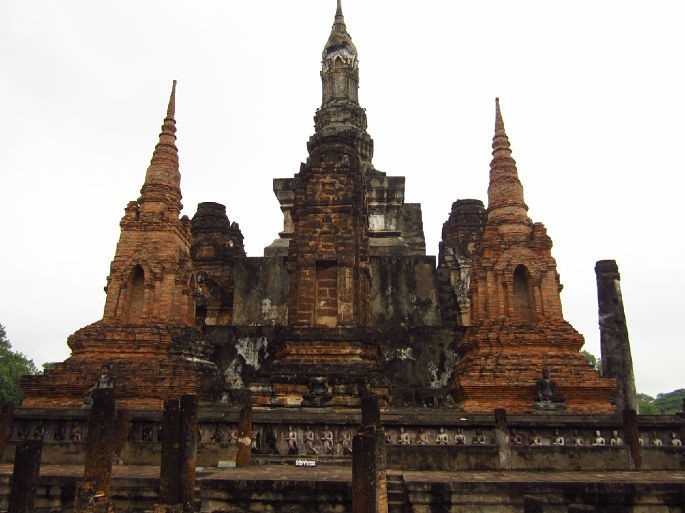
Wat Mahathat, Mahthat Temple in Sukhothai Historical Park
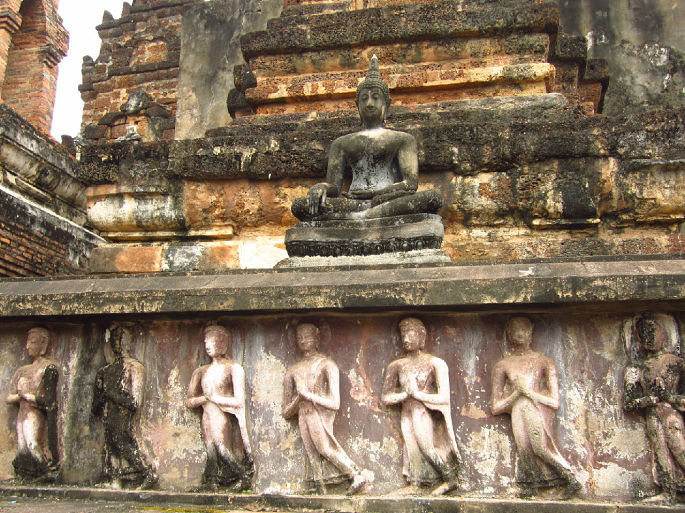

Photo taken at Wat Mahathat, Mahthat Temple in Sukhothai Historical Park

Wat Mahathat, Mahthat Temple in Sukhothai Historical Park
Coming out of Mahatai Temple, we went south to the nearby Wat Si Sawai Temple. The two temples are about 300 meters apart.
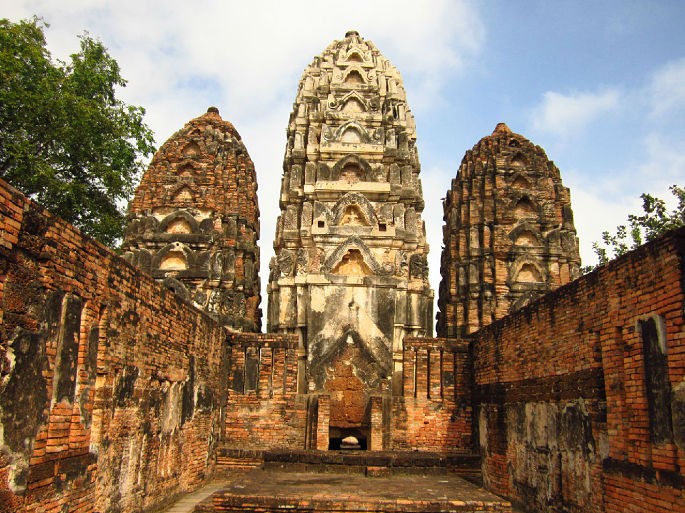
Wat Si Sawai Temple in Sukhothai Historical Park
Wat Si Sawai, located to the south of Mahatai Temple, was first built by Khmer people from the 12th to 13th centuries as a Hindu temple and later became a Buddhist temple. There are not many pedestals in the pagoda, but they can bear the weight of the thick tower body. Each tower has an inner chamber, and the middle pagoda is connected to the temple through a tunnel. There are also some Hindu relics in the temple. There is a large green lawn in front and a moat beside it. It is picturesque.
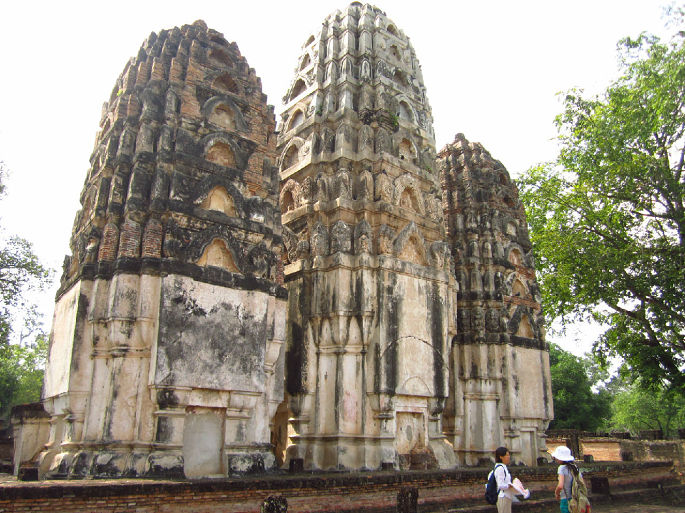
The three towers of Wat Si Sawai in the Sishawar Temple in Sukhothai Historical Park represent Brahma, Shiva and Vishnu, the three main Hindu gods respectively.

Green moss on a small lake in Sukhothai Historical Park
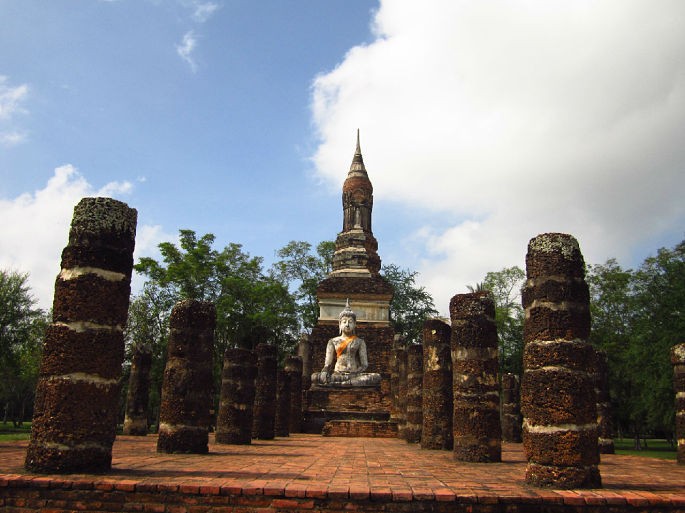
Wat Tra Phang Ngoen next to Zhuonan Temple (also known as Yinchi Temple) in Sukhothai Historical Park
Wat Tra Phang Ngoen is located about 300 meters west of Mahatai Temple. She also has a beautiful name called Yinchi Temple. This ancient temple has no walls. There is a huge sitting Buddha and a Sri Lankan-style pagoda. Not far from it is a red brick wall with a intact walking Buddha statue. It is full and round, with elegant skirts and natural and graceful manners.
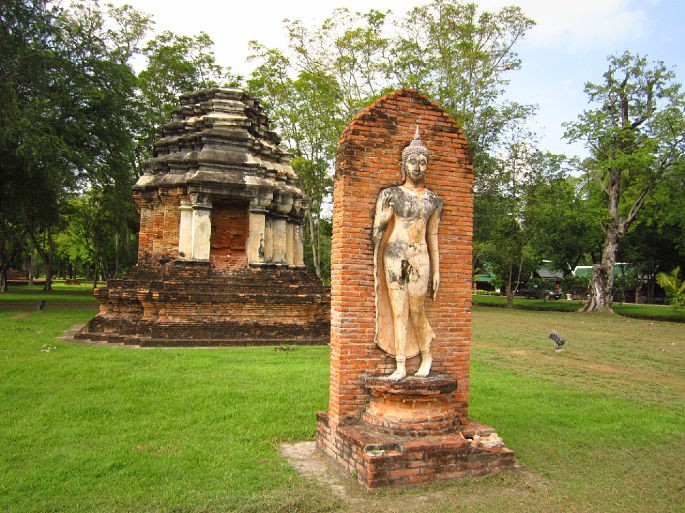
Standing and Walking Buddha of Wat Tra Phang Ngoen in Zhuopangnan Temple
After visiting Zhuobangnan Temple, I found that one of our bicycles was short of gas. It was not far from the gate. I talked to the ticket inspector at the gate post and came back from the car rental office with enough gas. Then I went on a tour from Wat Mai to the north of the gate.

Wat Mai in Sukhothai Historical Park
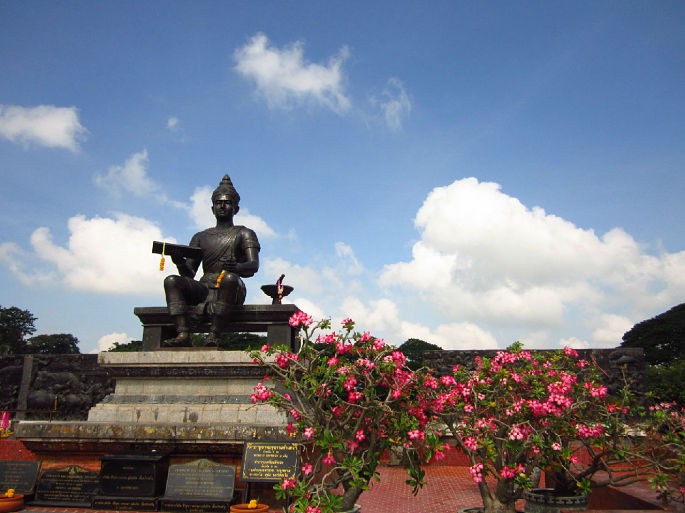
Statue of King Ramkhamhaeng Monument in Sukhothai Historical Park
King Ramkhamhaeng, the third king of the Sukhothai dynasty, was an accomplished monarch. During his reign, he created Thai script by improving Khmer script and created the famous Songkhalok porcelain Sangkhalok Crockery.

The lotus lanterns in Sukhothai Historical Park are very local in style.
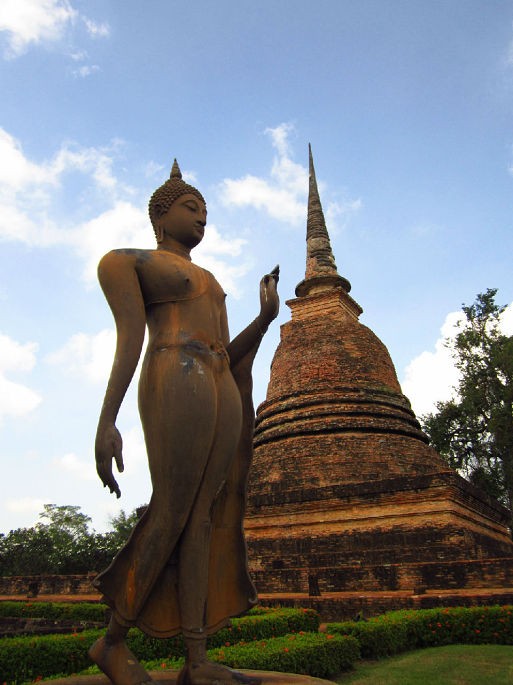
The famous Shaxi Temple Wat Sa Si Walking Bronze Buddha
Wat Sa Si of Shaxi Temple is built on an island in the middle of the lake. There are long reflections of coconut trees, large green lawns and sitting Buddha in the temple with only stone pillars left. However, the most touching one should be the bronze statue of walking Buddha. Buddha’s body is full, his lines are smooth and soft, his right hand is drooping, his fingertips are slightly tilted, and his left hand is raised, posing as a gesture of saying and printing. The image of Buddha has changed from the seriousness of the past to the variety of Arrow, free from vulgarity and vivid. It is one of the best in the historical park.

Wat Sa Si Sitting Buddha at Shaxi Temple in Sukhothai Historical Park
After seeing the main scenic spots in the old city center, We visited a series of sites from the west gate to the west of the city. Tickets are also (100 +10) TB/person. At this time it is noon, the scorching sun is in the sky, which is a hot word. Although I know that these scenic spots in the west of the city are not as beautiful as those in the upper old city that I have just seen, I am really unwilling not to look at them in person. Fortunately, these main sites in the west of the city are distributed on both sides of a main road, and although there are many scenic spots, I can continue to visit them.

Wat Si Thon located in the west of the ancient city of Sukhothai Historical Park
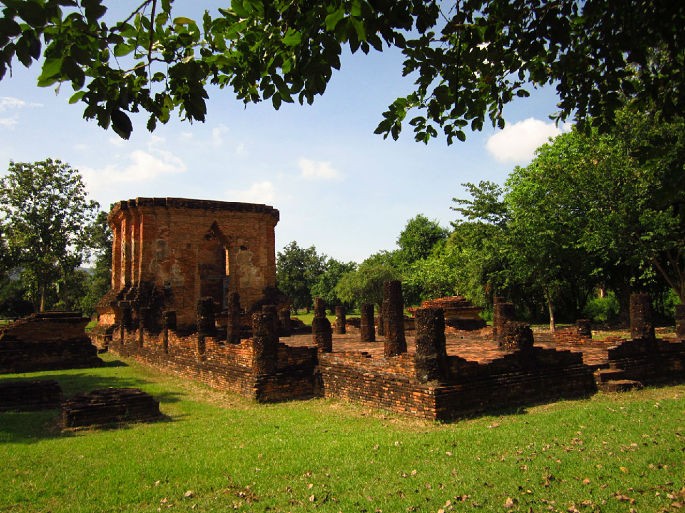
Wat Tuk located in the west of the ancient city of Sukhothai Historical Park

Cycling in Sukhothai Historical Park in the west of Gucheng City
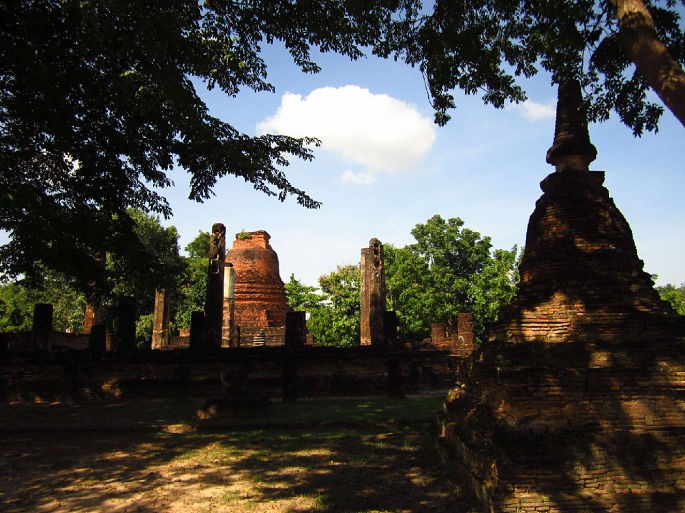
Wat Mangkorn in the west of the ancient city of Sukhothai Historical Park
After resting in the dense shade of Wat Mangkorn for more than 20 minutes, I went back to a shabby canteen not far away and bought two bottles of water, a banana and a bag of banana slices, which cost only 55TB in total, which is not at all like the price in the scenic spot.

Beautiful cockscomb-like plants along the roadside of Wat Mangkorn
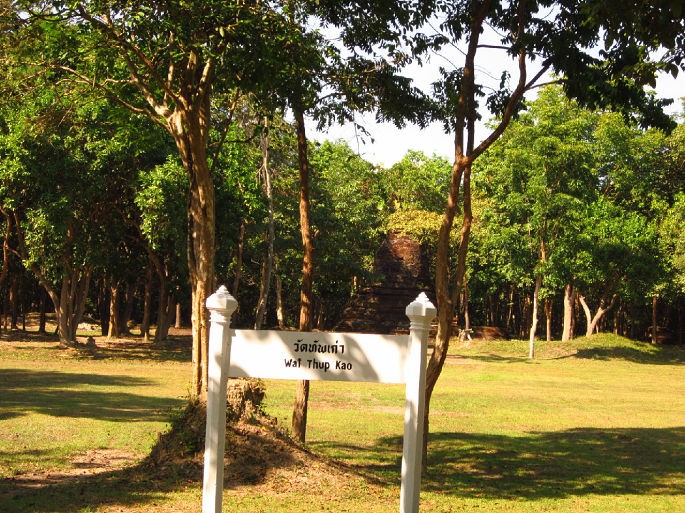
Wat Thup Kao located in the west of the ancient city of Sukhothai Historical Park
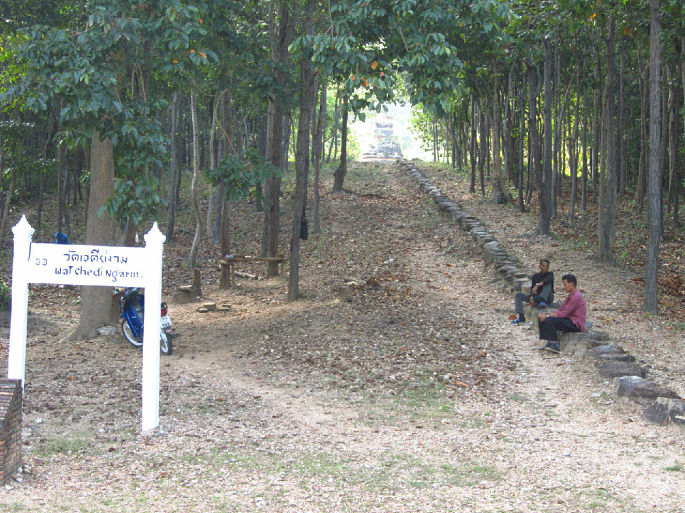
At the entrance to Wat Chedi Ngam, he didn’t have the courage to climb up

Wat Chang Rop in the west of the ancient city of Sukhothai Historic Park
Wat Chang Rop was built in the 14th to 16th centuries. It has a sand and stone structure. The center of the temple is a relic. The 24 elephant statues on the tower foundation are now incomplete. The whole temple is even more a broken image.

The mountain road to the top of the mountain, Mat Phra Bat Nai
Mat Phra Bat Nai was built on a high slope on the top of the mountain. Climbing up the top of the mountain, he looked up at the relatively well-preserved pagoda in the temple from under the slope. The black and red colors were very magnificent and magnificent.

The imposing Mat Phra Bat Nai on the top of the mountain.
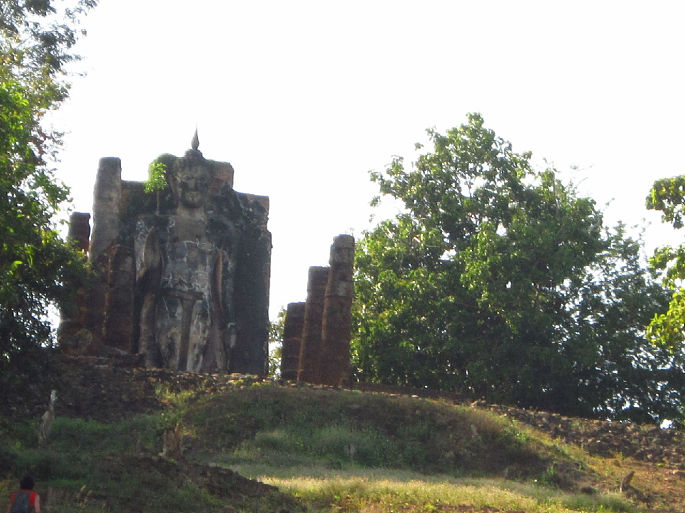
Looking up at Wat Saphan Hin on the hillside from the main road below the mountain.
Shapanxin Temple was built on a hill 200 meters high. “Sha Panxin” means “Stone Bridge” and refers to the flagstone step road leading to the mountain-it is still there. Standing on the top of the mountain, you can have a good view of Sukhothai Ruins Park and the nearby peaks. The remains of the temple also include some pagodas and stone pillars, as well as a 12.5-meter-high standing Buddha. Having just come down from Mat Phra Bat Nai on the top of the mountain, I really don’t want to climb the mountain again. I have to look up at the majestic Buddha of Wat Saphan Hin on the mountain from a distance.
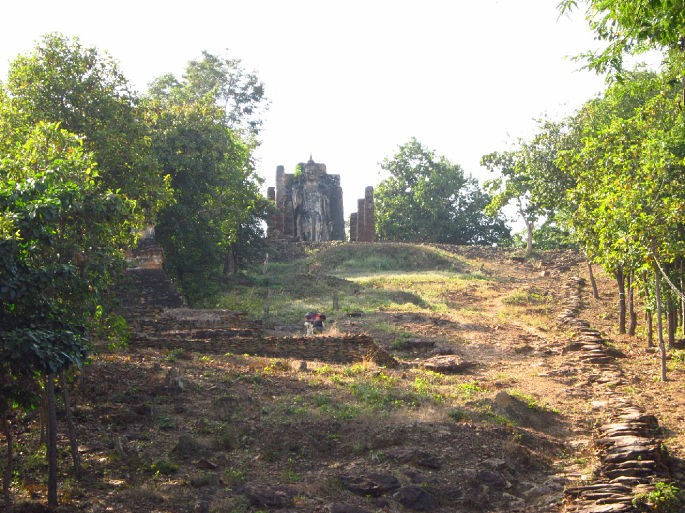
The uphill junction to Wat Saphan Hin
It was noon when I came out of the old city and headed west of the city. At that time, we thought there would be a restaurant ahead. But there was no place to have lunch all the way down. Fortunately, a canteen on the road sold us a banana and banana slices to appease our hunger. In this way, we strolled down the U-shaped route in the west of the city and returned to the north gate of the old city to visit the scenic spots in the north of the city.
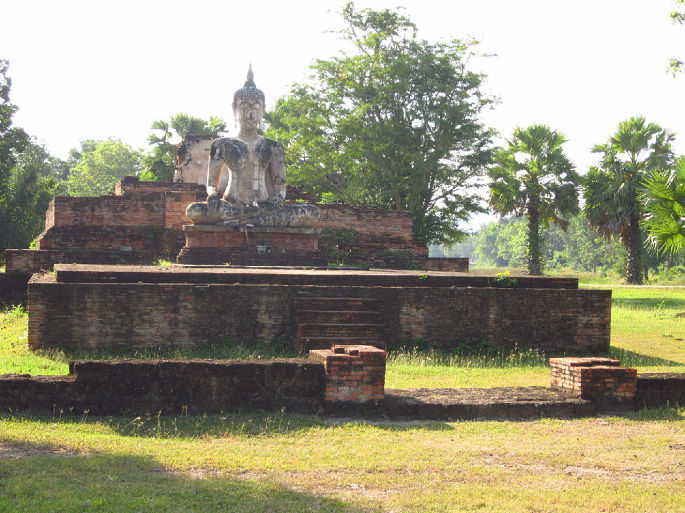
Wat Mae Chon located in the north of the ancient city of Sukhothai Historical Park
Wat Mae Chon is located on the roadside outside the north gate of the ancient city of Sukhothai, south of WatPhraPhaiLuang. According to records, the temple originally had a temple built on a 7.50 m * 11.45 m base. After the temple stood three pagodas, and in the northwest there was an ancient well with a diameter of about 1 m and an embedded stone slab. However, these former buildings are now only dilapidated ruins and can no longer see their original appearance. Only one sitting Buddha is well preserved.
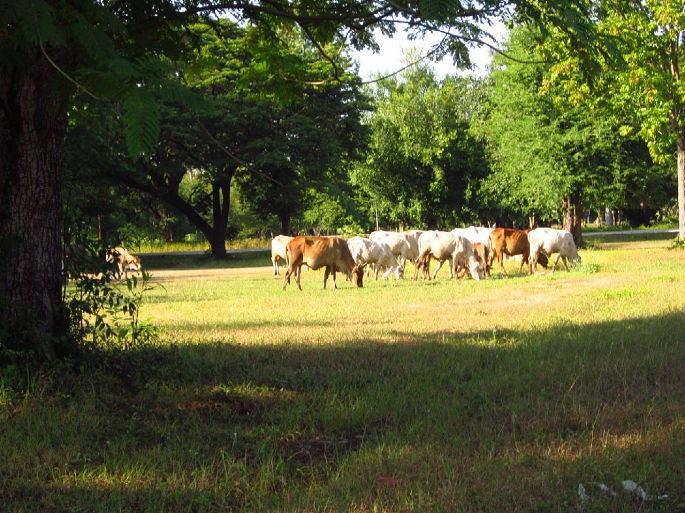 位于素可泰历史公园古城北的Wat Phra Phai Luang里的牛群
位于素可泰历史公园古城北的Wat Phra Phai Luang里的牛群
Wat Phra Phai Luang, located 500 meters north of the city wall, is the second most important temple after Mahattai Temple. It is a typical Khmer-style temple complex. It is generally believed that it was built in the middle of the 13th century. The pagoda on the east side of the temple is surrounded by the sitting Buddha on its base. The original three Khmer pagodas in the temple are larger than the same type pagodas in the Xisha site, but now there is only one on the north side. The surface of the pagoda is decorated with exquisite reliefs, depicting various Buddha postures, and now only a small part remains. The remains of WatPhra Phai Luang are on an island, which is actually the layout of a city. Outside is a moat, and the water is full of duckweed, but the area is very small like an island. A little isolated. The entrance is to the west, and it takes half a circle to get there. However, there is a wooden bridge in the east that can be passed through. Although it is written that no traffic is allowed, there is a dilapidated entrance. Obviously, many people enter and leave from here. We are even more lazy to turn around and go in directly. We actually save running roads and tickets. Although a little embarrassed, at this time also can’t take care of so much.
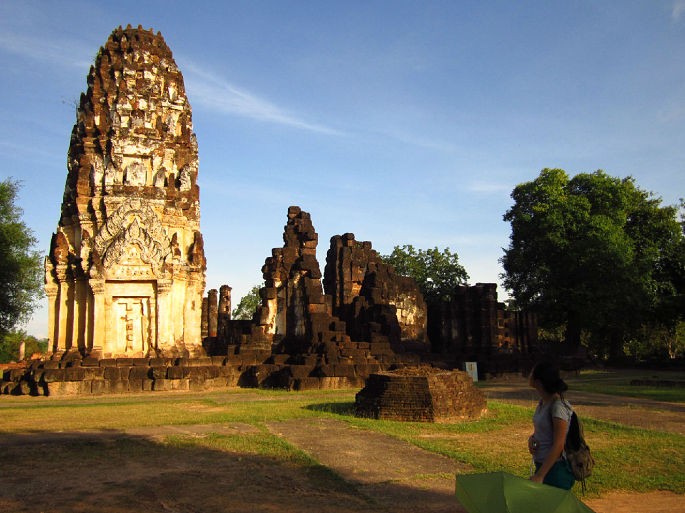
Wat Phra Phai Luang, located in the north of the ancient city of Sukhothai Historical Park

Wat Phra Phai Luang, located in the north of the ancient city of Sukhothai Historical Park
It was already 4: 30 p.m. When we returned to the old city from the north of the city. After running under the scorching sun for a day, we had not even eaten lunch. We decided to end today’s trip and return the car to the hotel to rest.

Our car rental company is located not far from the gate of Sukhothai Historical Park (opposite)
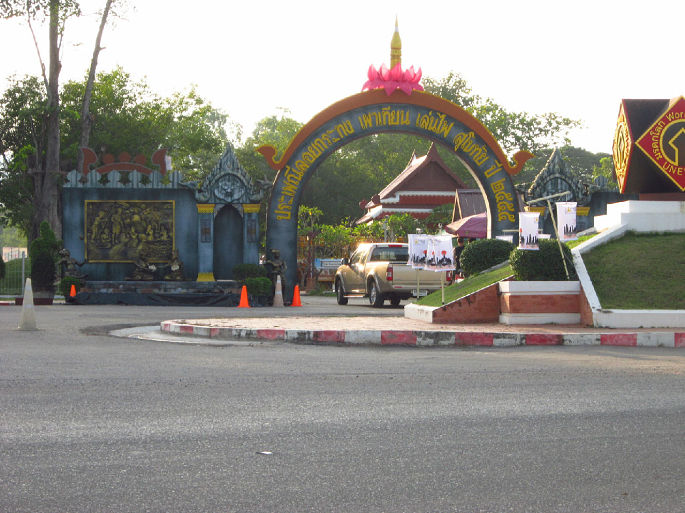
Gate of Sukhothai Historical Park
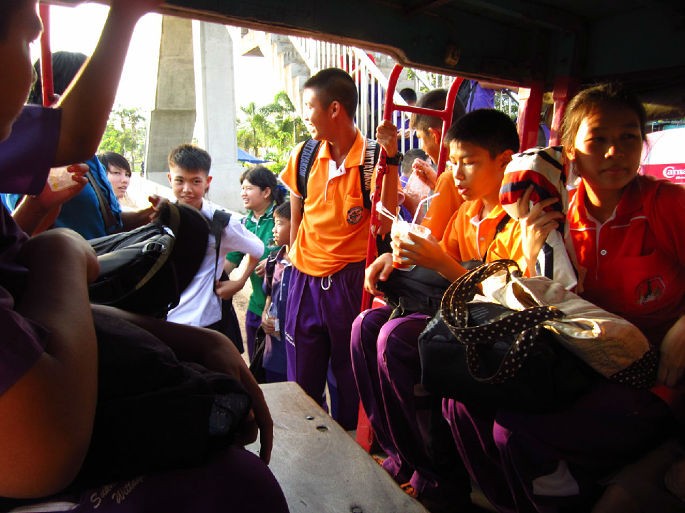
When we returned to the hotel, a large group of local students who had just finished school arrived on our two cars. All looked sunny.
Take a two-car back to the hotel, 30TB/person. Then a group of students got on the bus just after school. Although the bus was immediately crowded, the laughter and noise all the way made people feel happy. What I feel with them is sunshine!
After returning to the hotel to wash, I immediately came down to eat in the internal restaurant. When the ordered food was served and filled the table, I attracted amazing eyes one by one. Where did they know that this was also our lunch?
November 14, 2012
In order to catch the 8: 00 a.m. bus to Si Satchanalai Historical Park West Satchanalai Historical Park, we got up at 6: 00 a.m. and bought some things at 7-even next to the downstairs for breakfast. After eating, we left for the bus station. There is no through bus from Sukhothai to West Satchanalai Historical Park. There are many passing buses. We bought the 8: 00 bus to Chiang Rai, and the fare is 50TB/person.
The train leaves at 8:00 on time. When getting on the bus, tell the conductor where we are going. And asked him to tell us then. There were many people getting off the bus along the way. It was 9: 30. The kind conductor reminded us to get off. Next to the exit point is a bicycle rental office. This is also the only place in Sisachanale Historical Park that offers car rental. Go straight ahead and the entrance to the park is. Each of us rented a bicycle at a price of 30TB per person. The boss was very enthusiastic and reminded us that the latest bus back to Sukhothai in the afternoon was at about 4 o’clock. Don’t delay, and gave us a map of the historical park in Sisachanalai.

Suspension bridge on the Yom River to the entrance to Si Satchanalai Historical Park West Satchanalai Historical Park
On the other side of the river, at the end of the suspension bridge, is the first ticket booth of Si Satchanalai Historical Park. The ticket price is 30TB per person. This ticket is mainly aimed at several ruins between here and the ancient city of the Historical Park.
Sisachanalai Historical Park is located on the Yong River, 55 kilometers north of Sukhothai Historical Park, covering an area of 45 square kilometers. It is the site of the sister ancient city of Sukhothai Historical Park and has also been designated as a world cultural site by UNESCO. Its basic style is the same as that of the ruins in Sukhothai Historical Park, but the environment is more peaceful and undamaged.

Wat Phra Si Rattana Mahatath in Sisa Chanalai Historical Park
Wat Phra Si Rattana Mahatath, built in 1448-1488, is close to the entrance. It contains a large brick pagoda located in the middle of the two main halls. In one of the main halls, there is a bas-relief work of a large sitting Buddha, a slightly smaller standing Buddha and a famous walking Buddha, which can be called a model of Sukhothai style with streamlined and boneless lines.
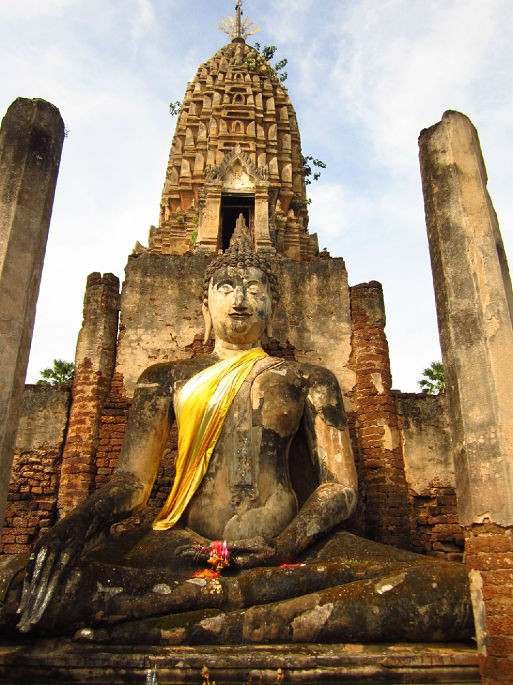
Wat Phra Si Rattana Mahatath in Sisa Chanalai Historical Park
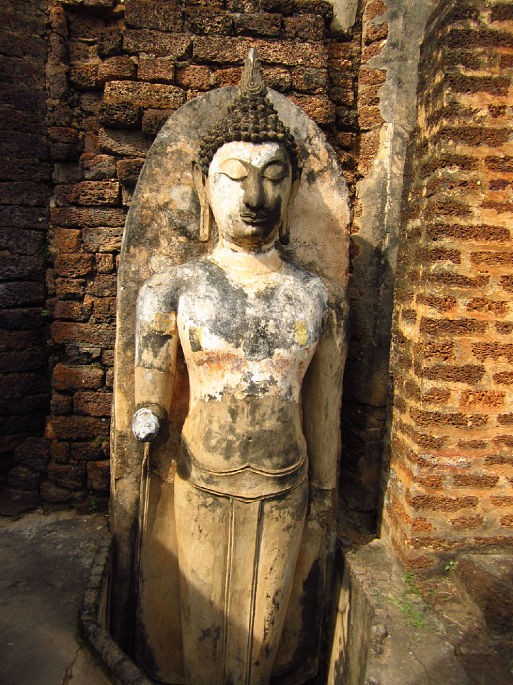
Wat Phra Si Rattana Mahatath in Sisa Chanalai Historical Park
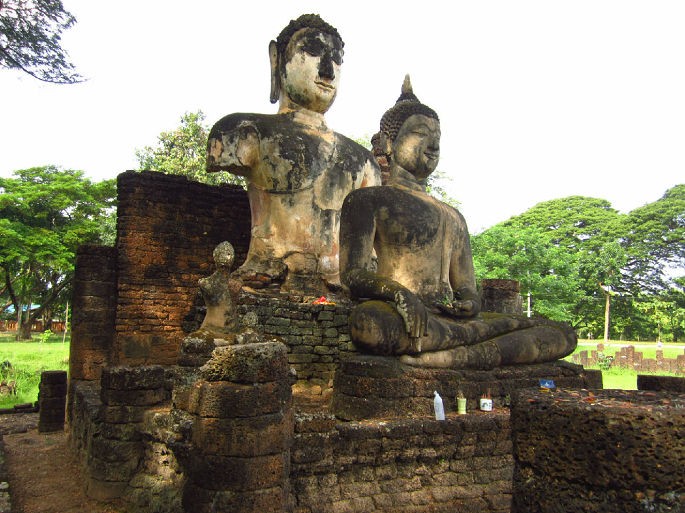
Wat Chao Chan in Sisa Chanalai Historical Park
Wat Chao Chan is located about 500 meters west of Wat Phra Si Rattana Mahatath. The most eye-catching thing here is a Khmer-style pagoda that may have been built in the 11th to 12th centuries. To the right of the pagoda is a huge well-preserved standing Buddha.
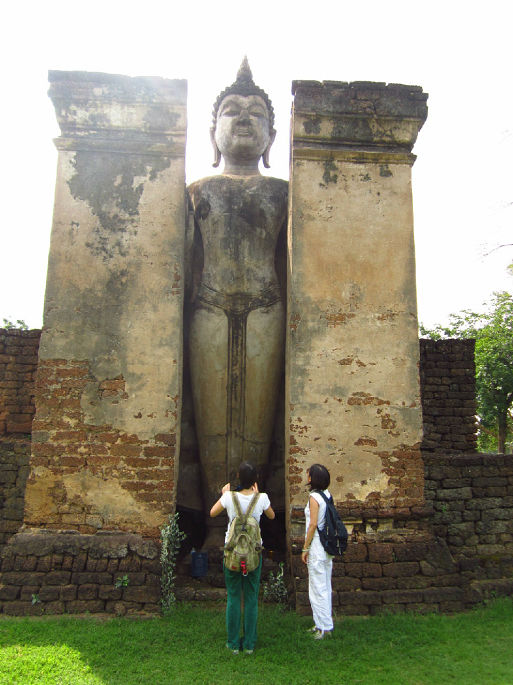
Wat Chao Chan’s Tall Buddha in Sisa Chanalai Historical Park

Wat Chao Chan Pagoda in Sisa Chanalai Historical Park
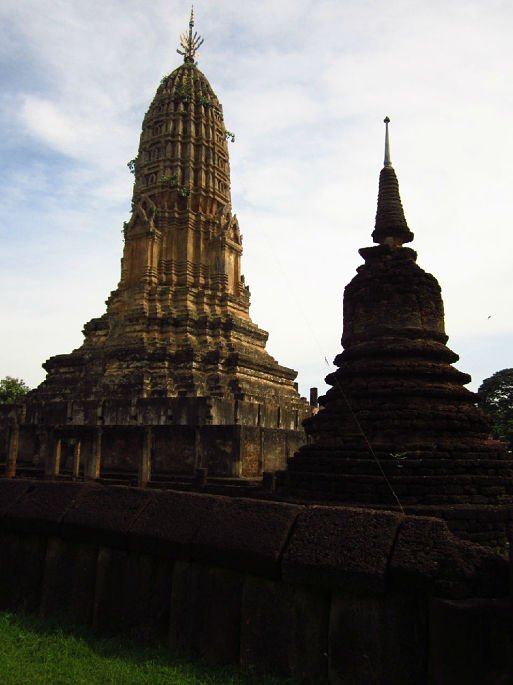
Wat Chao Chan in Sisa Chanalai Historical Park

Wat Khok Singkaram in Sisachanalai Historical Park
Not far west from Wat Khok Singkaram is the ruins of the ancient city of Sisachanalai Historical Park. Many of the park’s major scenic spots are in the ancient city. To enter the ancient city, you need to buy a separate ticket with a fare of 100TB/person.
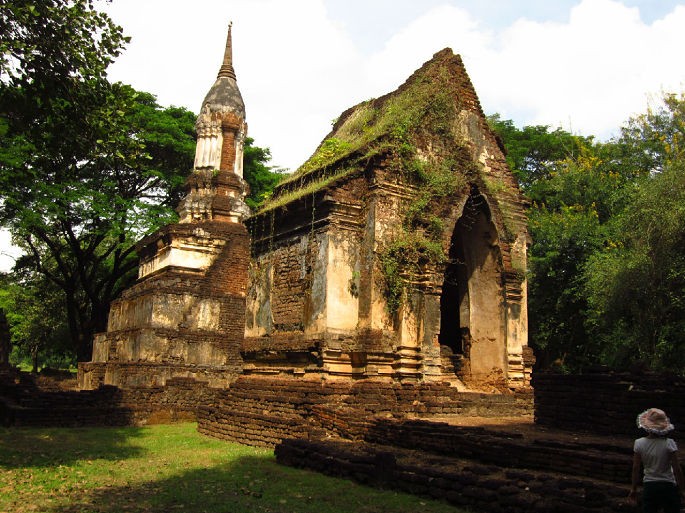
Wat Suan Keao Utthayan Noi in the Ancient City of Sisachanale Historical Park
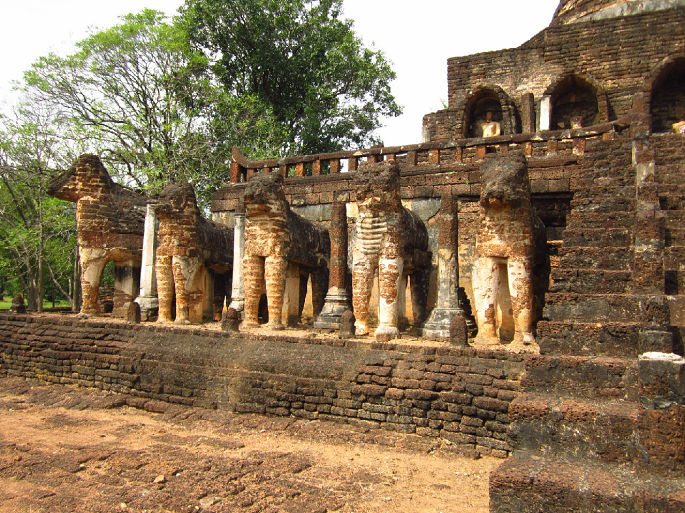
The Remnant Statue of Wat Chang Lom in the Ancient City of Sisa Chanalai Historical Park
Wat Chang Lom (Ring Elephant Temple) is the center of the old city of Sisachanalai. There is a bell-shaped pagoda surrounded by elephant reliefs. Pagodas are better preserved than similar pagodas in Sukhothai. Some documents say that the temple was built by King Lankanheng between 1285 and 1291.
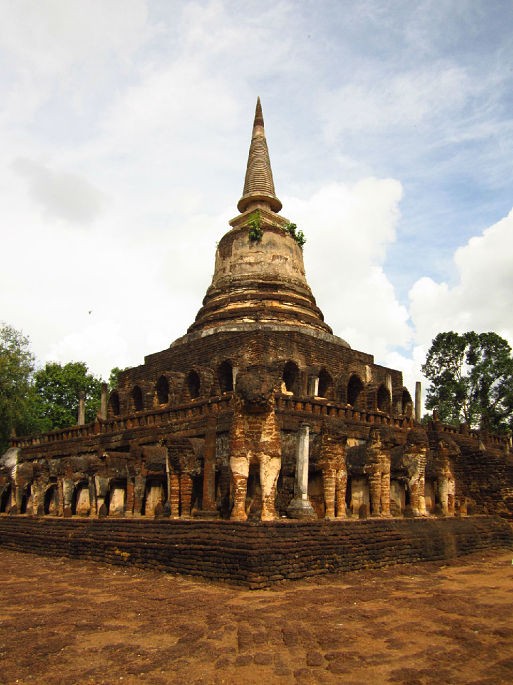
Wat Chang Lom Pagoda in the Ancient City of Sisa Chanalai Historical Park
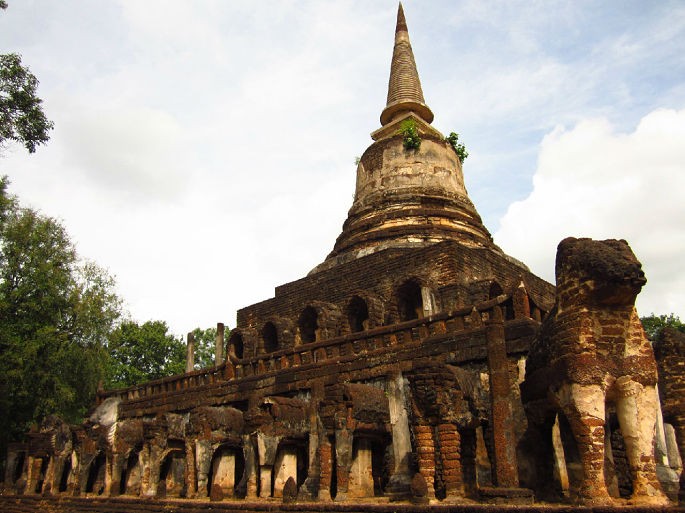
Wat Chang Lom in the Ancient City of Sisa Chanalai Historical Park
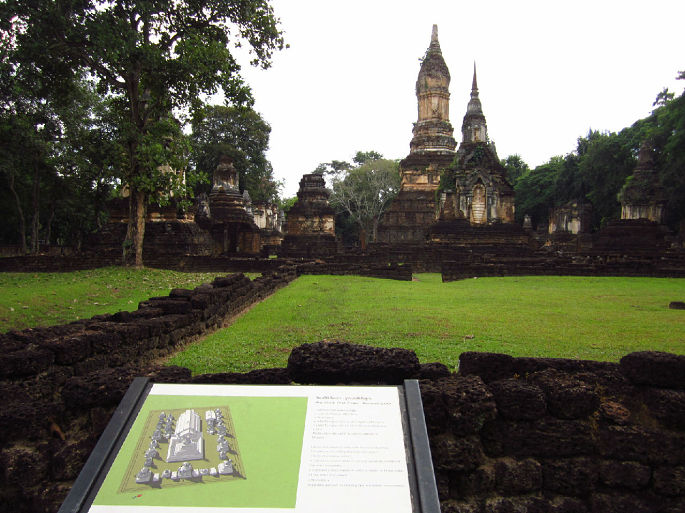
Wat Chedi Ched Thaeo and Its Original Appearance in the Ancient City of West Sachanalai Historical Park
Wat Chedi Ched Thaeo has seven rows of pagodas, and the main tower has a typical Sukhothai-style rooftop with flowers.
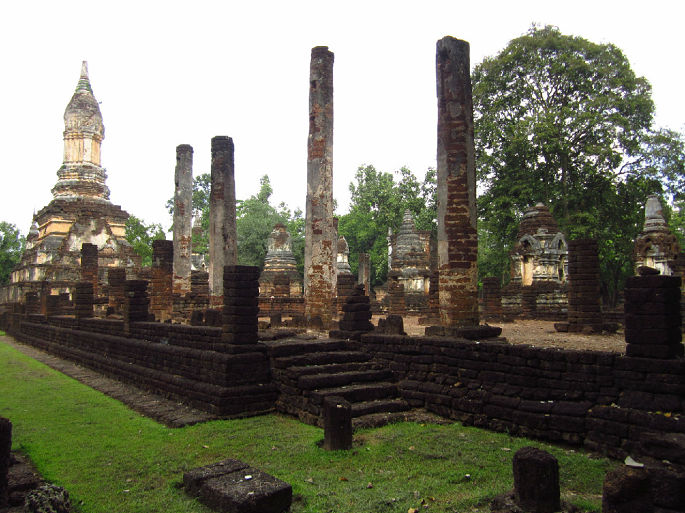
Wat Chedi Ched Thaeo in the Ancient City of Sisa Chanalai Historical Park

Four-Leaf Grass-Lucky Grass Beside Wat Chedi Ched Thaeo in the Ancient City of Chanalai Historical Park in West Sasa
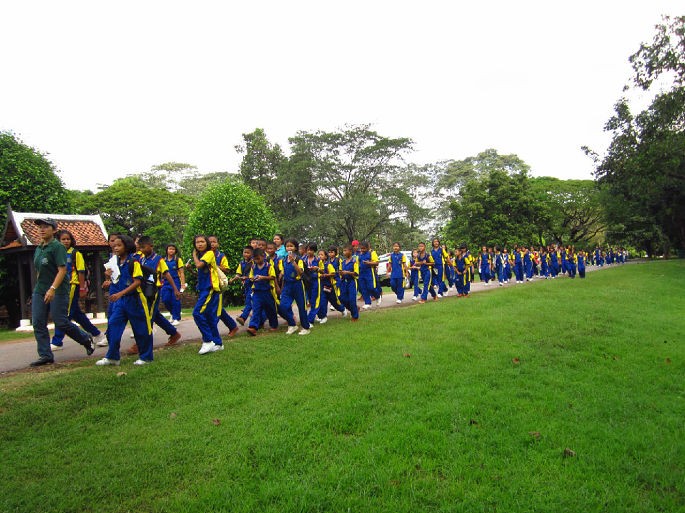
Local students visiting the ancient city of Sisachanalai Historical Park
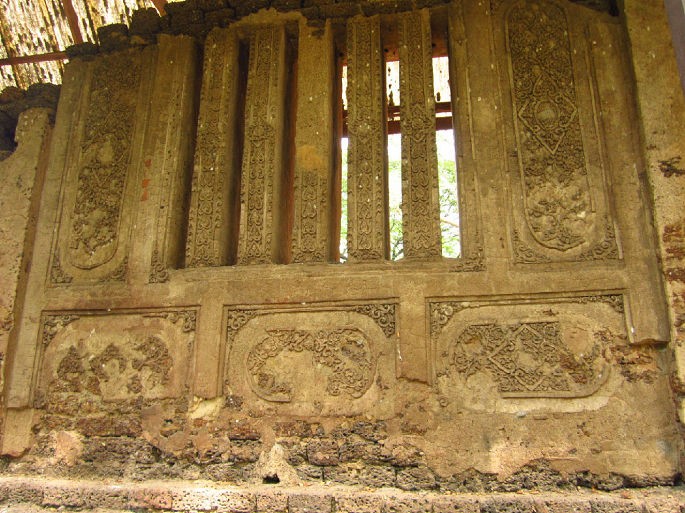
The well-preserved walls of Wat Nang Phraya in the ancient city of Sisachanalai Historical Park.
Wat Nang Phraya was built in the 15th century. The Sinhalese-style pagoda is small and well-preserved. The main attraction here is the only well-preserved lashed stucco relief wall left in the whole park above, which can give people a chance to understand the style of the original temple building. The wall is now protected by tin ceilings.

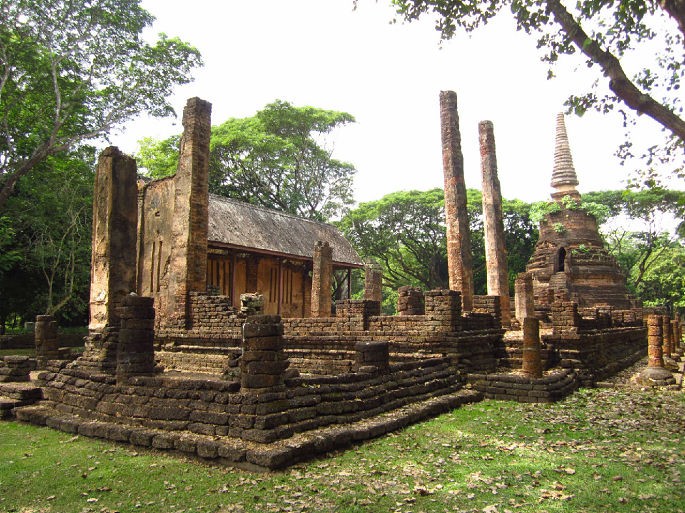
Wat Nang Phraya in the Ancient City of Sisachanale Historical Park
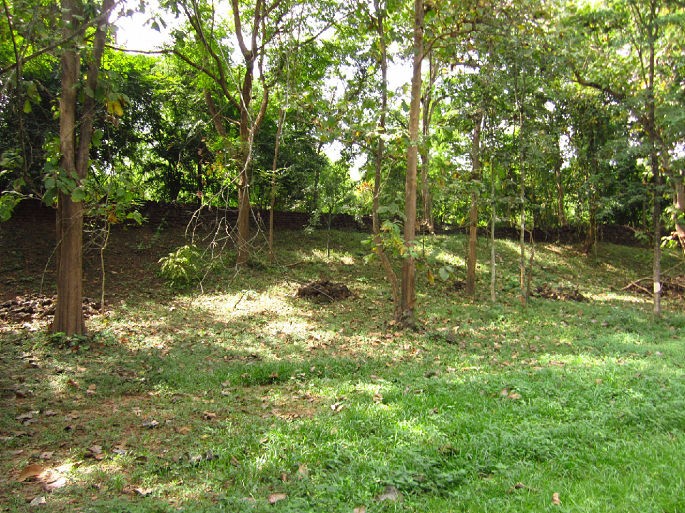
The Ancient City Wall in the Historical Park of Sisachanalai

Wat Khao Suwankhiri, built on the top of the mountain in the ancient city of Sisachanalai Historical Park.
We pushed our bike up the main road and climbed a big slope to reach the foot of the mountain where Wat Khao Suwankhiri was located. We laid the bike down the road and went up the steps to visit Wat Khao Suwankhiri on the top of the mountain.
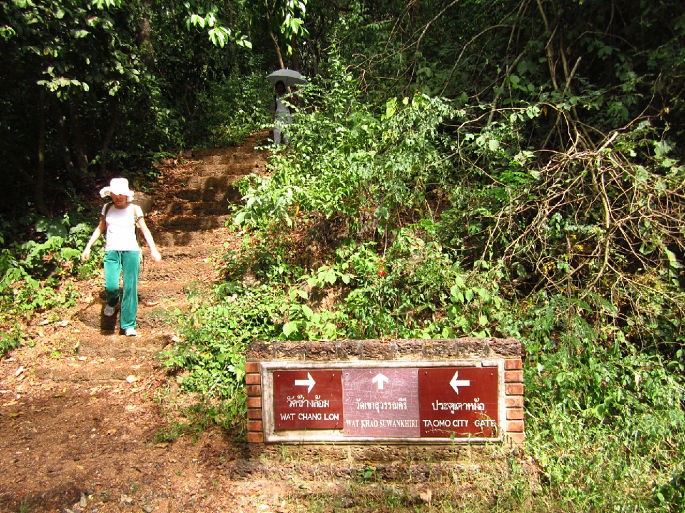
Wat Khao Suwankhiri Entrance in the Ancient City of Sisachanalai Historical Park
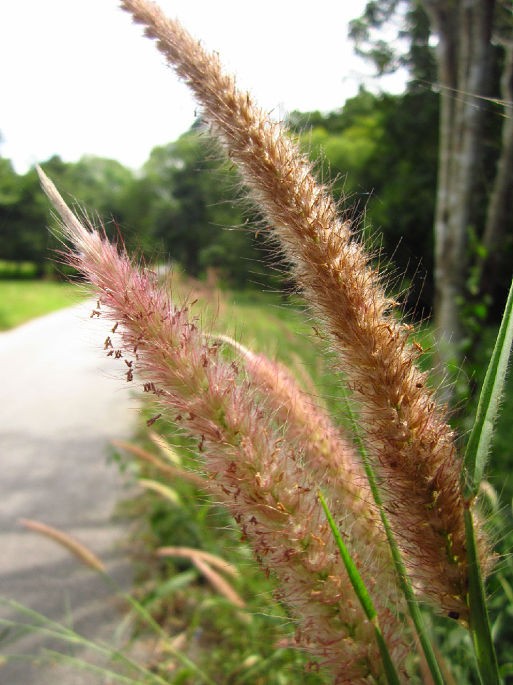
Mao Mao Grass on the Roadside at the Bottom of Wat Khao Suwankhiri Mountain in the Ancient City of West Sachanalai Historical Park

Wat Khao Phanom Phloeng, built on the top of the mountain in the ancient city of Sisachanalai Historical Park, sits on the Buddha.
Wat Khao Phanom Phloeng and Wat Khao Suwankhiri are located on two tops of the same mountain, but each has its own way up the mountain.

Wat Khao Phanom Phloeng, built on the top of the mountain in the ancient city of Sisachanale Historical Park.

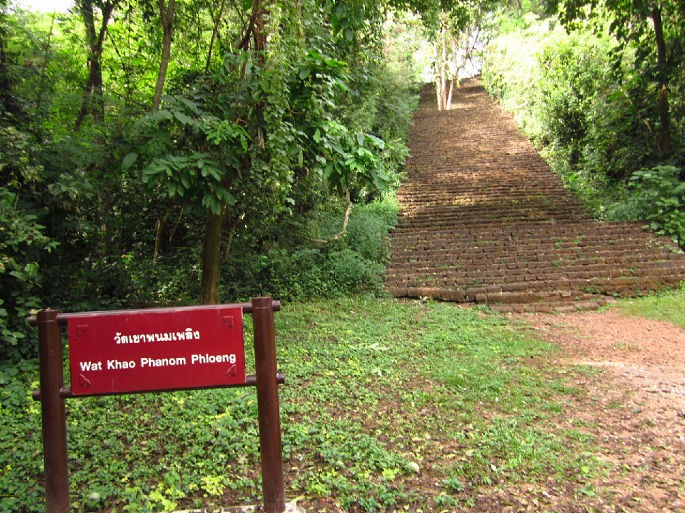
The entrance steps of Wat Khao Phanom Phloeng built on the top of the mountain in the ancient city of Sisachanale Historical Park.
So far, we have basically visited the entire Sisachanalai Historical Park and cycled back the same way.
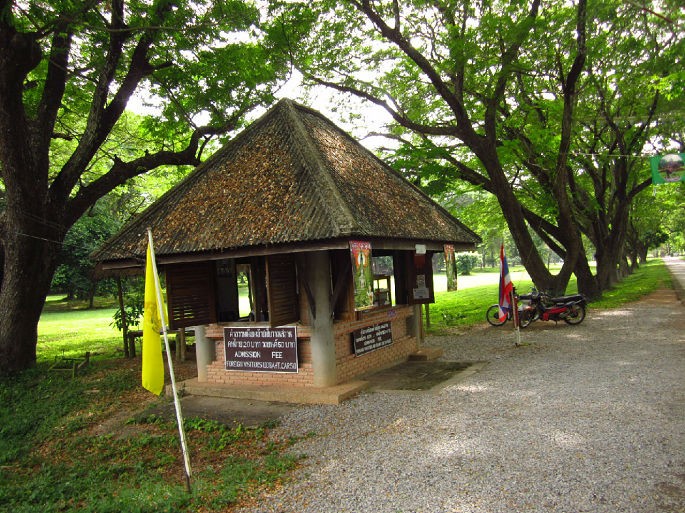
Ticket Office of Main Attractions in the Ancient City of West Sachanalai Historical Park
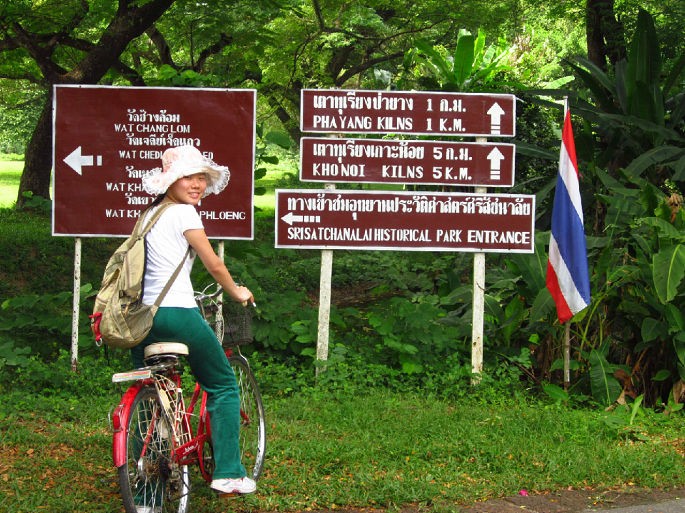
Signs in the Historical Park of Sisachanalai

Bird’s Nest in front of Residents’ Home near the Entrance of West Sachanale Historical Park on the North Shore of Yom River
It takes about 4 hours to visit the entire Sisachanalai Historical Park. At 2: As we were about to ride our bike to the rental office, Seeing the owner of the garage waving to us repeatedly, He made another gesture to the west of the road. It happened that a bus to Sukhothai was passing by. The boss was helping us to stop the bus. When we got to the door of the garage, we casually put the bus on the spot and ran to the bus that had stopped by the side of the road. At the same time, we turned back and waved goodbye to the kind owner of the garage.
Only after getting on the bus did we find that this is a luxurious long-distance bus, clean, spacious and comfortable, and the fare is not expensive, 50TB/person as when we came. Originally, it was an hour and a half when we arrived, but it only took us an hour to reach Sukhothai.
After getting off the bus, we bought a bus ticket to Chiang Mai at 9:30 the next morning at 239TB/person, and then spent 30TB to take a doodle bus back to the hotel.
November 15, 2012
I went to Chiang Mai today. I went to bed early last night. I woke up early this morning and walked around the streets of Sukhothai New Town in the morning.
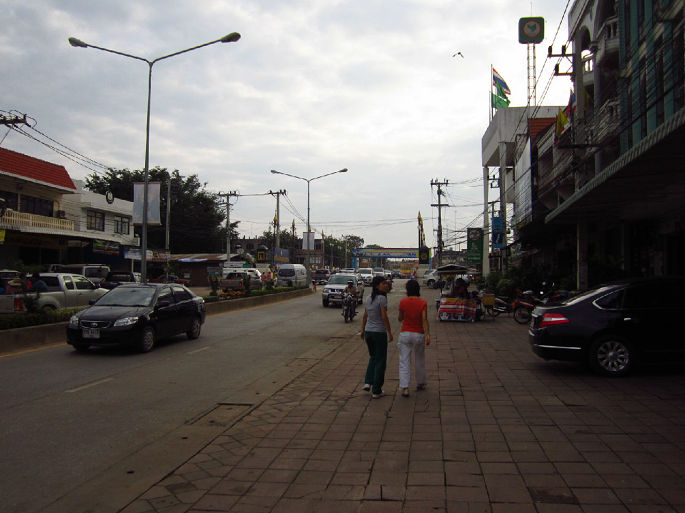
Street View of Sukhotai New Town in the Early Morning
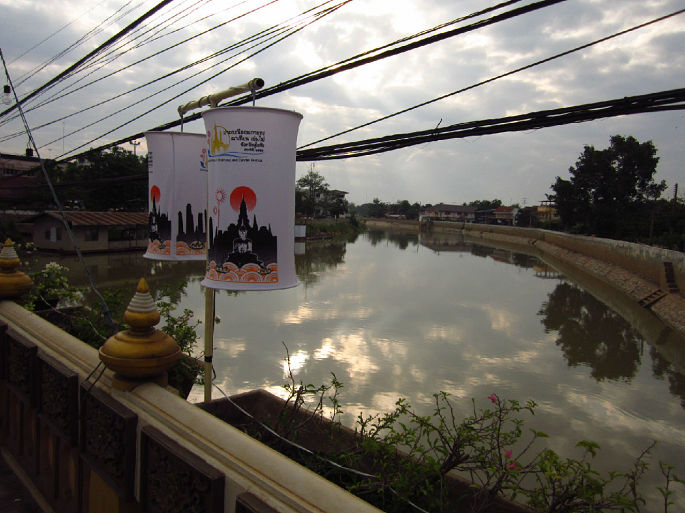
Yom River Crossing Sukhothai New Town
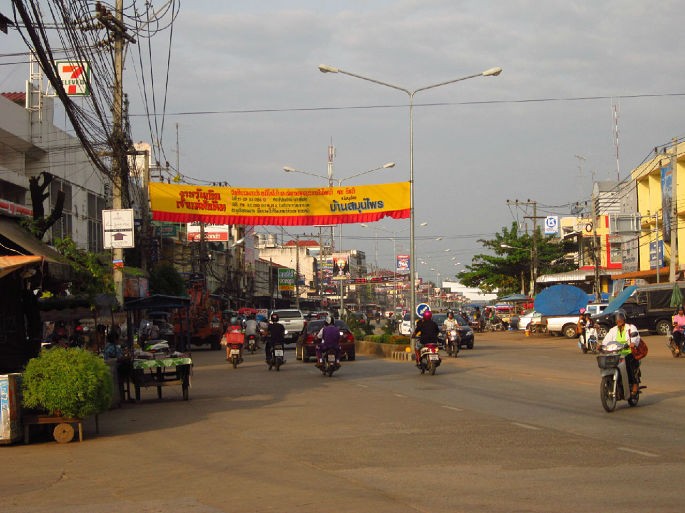
Street View of Sukhotai New Town
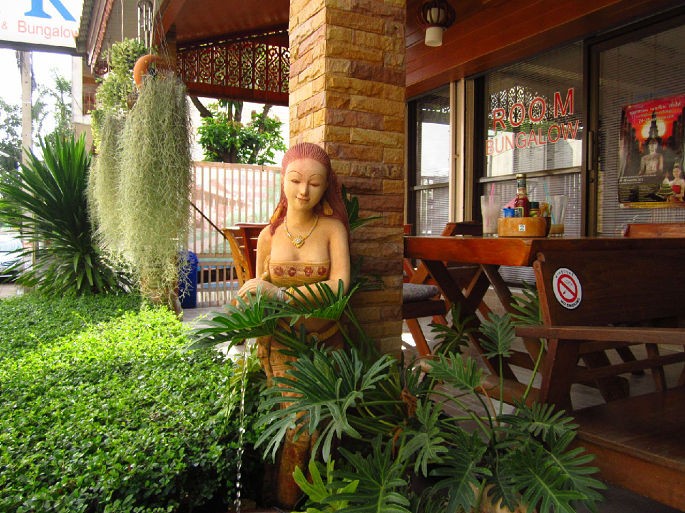
We stayed three nights in a very stylish Hotel.
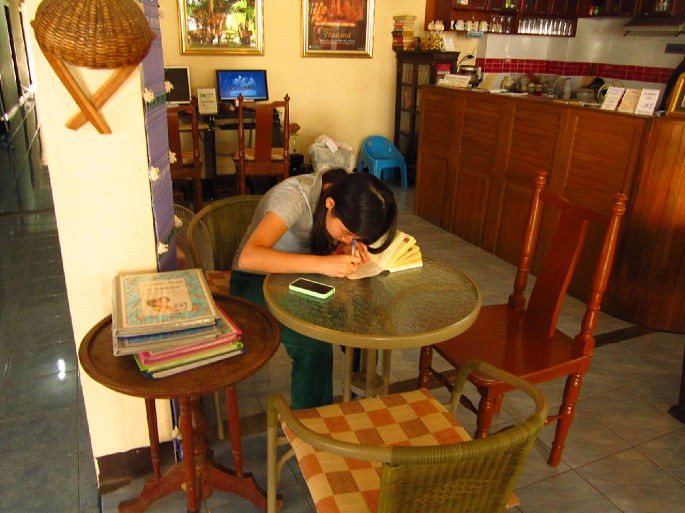
Message
The hotel owner recommended us a Chinese copy, It was a Shanghai girl who stayed here not long ago who stayed in the hotel specially before leaving. The book left a journey speech and microblog address, We got a reply soon after leaving a message on her microblog. We were all very excited by the common experience. In order to let this interesting relay continue, Check-out also left our comments on this book before leaving, hoping to give blessings to those who saw this book or even a little accident and surprise!
I stayed here for three nights and got familiar with my boss. After saying goodbye, I took a doodle bus to the bus station. At 9: 30 our bus left on time for Chiang Mai.
Postscript:
1. That average person visit Sukhothai only to visit the ruins of Sukhothai historical park, Located about 55 kilometres north of Sukhothai, As a world cultural heritage, the Sisachanalai Historical Park is of primitive simplicity, grandeur and splendor. Moreover, the transportation is very convenient. Compared with the numerous tourists in Sukhothai Historical Park, it is very quiet here. Most of the time, one scenic spot is visited by one’s own people. Therefore, it is recommended that if you go to Sukhothai, you must arrange an extra day to visit it. Almost everyone who has been here has a lucky feeling of being lucky.
2. Before visiting Sukhothai Historical Park, everyone will generally get a Map of Sukhothai Historical Park through different channels. It must be noted that the proportion of the ancient city and the outside of the city on this map is inconsistent (especially in the west part of the city, the distance is very short from the map, but the actual distance will be several times that on the map), so as to reasonably arrange the tour time.
3. It will be very tight to visit the main relics inside and outside the ancient city of Sukhothai Historical Park in one day. If possible, it is best to take lunch and rest on the road to eat. This will save time. Recommended itinerary sequence: Sukhothai Historical Park Ancient City Site Group-Ancient City South (Wat Chetuphon et al.) Site Group-Ancient City West (Ancient City West) Site Group-Ancient City North (Wat Si Chom and then WatPhra Phai Luang)-Ancient City East (Wat Chang Lom et al.). Of course, it can be adjusted according to your own plan.
4. The status of Sukhothai’s history and culture in Thailand cannot be described too much. From this perspective, one cannot say that one has really understood Thailand’s history without Sukhothai. One cannot say that one has really been to Thailand without Sukhothai.
Recent Comments